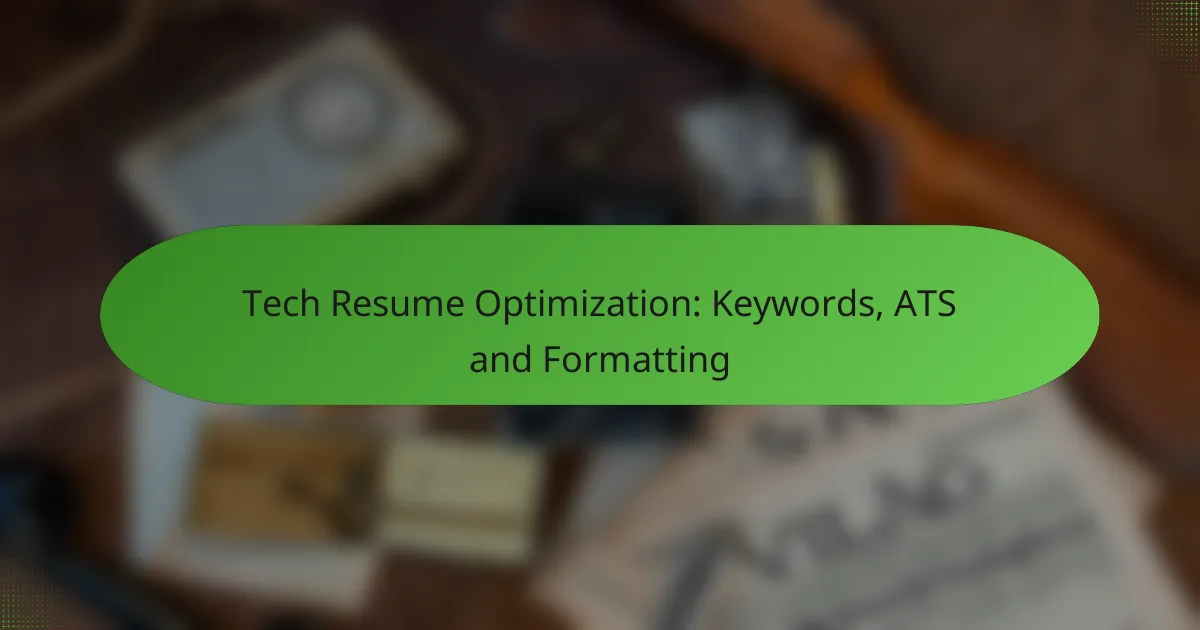Optimizing your tech resume for Applicant Tracking Systems (ATS) is essential for standing out in a competitive job market. By incorporating relevant keywords, adhering to standard formatting, and using concise language, you can enhance your resume’s readability for both software and hiring managers. Focus on including industry-specific terms and skills that align with the job description to increase your chances of getting noticed.

How to Optimize Your Tech Resume for ATS?
To optimize your tech resume for Applicant Tracking Systems (ATS), focus on using relevant keywords, standard formatting, and concise language. These elements help ensure that your resume is easily readable by both software and hiring managers.
Use relevant keywords
Incorporating relevant keywords is crucial for passing ATS filters. Analyze job descriptions to identify commonly used terms and phrases that align with your skills and experience. For instance, if a job listing emphasizes “JavaScript” and “Agile,” make sure to include these keywords in your resume.
Avoid generic terms; instead, use specific technical skills, tools, and methodologies that are pertinent to the roles you are targeting. This targeted approach increases your chances of being flagged as a strong candidate.
Follow standard formatting
Standard formatting is essential for ATS compatibility. Use a simple layout with clear headings, consistent fonts, and adequate spacing. Avoid complex designs, graphics, or unusual fonts that may confuse the ATS.
Stick to common file types like .docx or .pdf, as these are typically more ATS-friendly. Ensure that your contact information is easily accessible at the top of the resume.
Incorporate specific job titles
Including specific job titles in your resume can enhance its relevance. Tailor your resume to reflect the job titles mentioned in the job description, as this aligns your experience with what employers are seeking.
For example, if the position is for a “Senior Software Engineer,” ensure that your previous roles reflect similar titles or responsibilities. This alignment helps the ATS recognize your qualifications more effectively.
Utilize bullet points
Bullet points help improve readability and highlight key achievements. Use them to list your responsibilities and accomplishments in each role, making it easier for both ATS and hiring managers to scan your resume quickly.
Start each bullet point with strong action verbs and quantify your achievements when possible. For instance, “Developed a web application that increased user engagement by 30% over six months” provides clear evidence of your impact.
Keep it concise
A concise resume is more likely to be read in full. Aim for one page if you have less than ten years of experience, and no more than two pages for more extensive careers. Focus on the most relevant information that showcases your skills and accomplishments.
Eliminate unnecessary details, such as outdated skills or unrelated job experiences. A well-organized, succinct resume will stand out to both ATS and human reviewers.

What Keywords Should You Include?
Including the right keywords in your tech resume is crucial for passing Applicant Tracking Systems (ATS) and catching the attention of hiring managers. Focus on relevant technical skills, industry-specific terms, soft skills, and phrases from the job description to optimize your resume effectively.
Technical skills keywords
Technical skills keywords are specific abilities or tools relevant to your field, such as programming languages, software, and methodologies. For example, if you are a software developer, include terms like “Java,” “Python,” “Agile,” or “Cloud Computing.” Tailor these keywords to match the technologies mentioned in the job listing.
To enhance your visibility, consider using a mix of both popular and niche technical skills. This approach can help you stand out in a competitive job market while ensuring that your resume aligns with the requirements of the position.
Industry-specific terms
Industry-specific terms are jargon or phrases commonly used within your field. For instance, if you are in cybersecurity, terms like “penetration testing,” “firewalls,” and “intrusion detection” should be included. These keywords demonstrate your familiarity with the industry and can resonate with recruiters.
Research the latest trends and terminology in your industry to ensure your resume remains current. This can include certifications or frameworks that are highly regarded, such as “ISO 27001” for information security professionals.
Soft skills keywords
Soft skills keywords refer to interpersonal abilities that enhance your effectiveness in the workplace, such as “communication,” “teamwork,” and “problem-solving.” While technical skills are essential, soft skills are increasingly valued by employers, especially in collaborative environments.
When listing soft skills, provide context or examples to illustrate how you’ve applied them in past roles. For instance, instead of just stating “leadership,” you might say “led a team of five in a project that improved system efficiency by 20%.”
Job description phrases
Job description phrases are specific terms and requirements mentioned in the job listing that you should mirror in your resume. This includes not only the required skills but also the responsibilities and qualifications outlined in the posting. For example, if the job description emphasizes “data analysis,” ensure this phrase appears in your resume where applicable.
To effectively incorporate these phrases, analyze the job description and identify the most frequently mentioned terms. Use these phrases naturally within your experience descriptions to enhance your chances of passing ATS filters and appealing to hiring managers.

How to Format Your Tech Resume?
Formatting your tech resume effectively is crucial for making a strong impression on potential employers. A well-structured resume enhances readability and ensures that key information stands out, especially when scanned by Applicant Tracking Systems (ATS).
Use a clean layout
A clean layout is essential for a tech resume, as it allows hiring managers to quickly find relevant information. Use ample white space to separate sections and avoid clutter. Aim for a single-column format that flows logically from one section to the next.
Consider using bullet points for lists of skills or accomplishments to enhance clarity. Avoid using excessive graphics or images, as these can confuse ATS software and detract from the overall professionalism of your resume.
Choose appropriate fonts
Selecting the right fonts can significantly impact the readability of your resume. Use standard fonts like Arial, Calibri, or Times New Roman, which are easy to read both on-screen and in print. Stick to a font size between 10 and 12 points for the body text.
Avoid decorative or overly stylized fonts, as they can be distracting and may not be compatible with ATS. Consistency in font choice throughout your resume is also key to maintaining a professional appearance.
Include clear section headings
Clear section headings help guide the reader through your resume and highlight important areas such as work experience, education, and skills. Use bold or slightly larger font sizes for headings to make them stand out.
Consider using consistent terminology for each section, such as “Professional Experience” instead of “Work History,” to ensure clarity. This uniformity helps ATS recognize and categorize your information correctly.
Maintain consistent spacing
Consistent spacing throughout your resume contributes to a polished look. Use uniform margins and line spacing to create a balanced layout. Typically, one-inch margins and 1.15 to 1.5 line spacing work well.
Be mindful of spacing between sections and within lists. Adequate spacing prevents your resume from appearing cramped and enhances readability, making it easier for hiring managers to scan your qualifications quickly.

What Are Common ATS Formatting Mistakes?
Common ATS formatting mistakes can hinder your resume’s chances of passing through automated systems. These errors often stem from using incompatible design elements that confuse applicant tracking systems, leading to missed opportunities.
Using images or graphics
Applicant tracking systems typically cannot read images or graphics, which means any important information contained within them is likely to be overlooked. Avoid including logos, charts, or any visual elements that do not translate into text.
Instead, present all your information in a text format. Use bullet points and clear headings to organize your content effectively, ensuring that key details like skills and experience are easily identifiable by the ATS.
Inconsistent font sizes
Inconsistent font sizes can confuse ATS software, making it difficult for the system to parse your resume correctly. Stick to one or two font sizes throughout your document to maintain clarity and uniformity.
A good rule of thumb is to use a larger font size (around 12-14 points) for headings and a standard size (10-12 points) for body text. This approach helps ensure that your resume is both ATS-friendly and visually appealing to human readers.
Overly complex layouts
Overly complex layouts can disrupt the flow of information and lead to parsing errors in ATS. Avoid using multi-column formats, text boxes, or unconventional section arrangements that may confuse the system.
Instead, opt for a straightforward, single-column layout with clear headings and consistent spacing. This simplicity helps both ATS and hiring managers quickly locate the information they need, improving your chances of making a positive impression.

How to Tailor Your Resume for Specific Jobs?
To tailor your resume for specific jobs, focus on aligning your skills and experiences with the job requirements. This involves customizing your resume for each application to highlight relevant qualifications and using appropriate keywords.
Analyze job descriptions
Begin by thoroughly reading the job description to understand the employer’s needs. Look for recurring themes, required skills, and specific qualifications that stand out. Take note of any industry-specific jargon or phrases that are frequently mentioned.
Consider breaking down the job description into key components such as responsibilities, required skills, and preferred qualifications. This will help you identify which aspects of your experience to emphasize in your resume.
Match keywords to requirements
Once you have analyzed the job description, the next step is to match relevant keywords to your qualifications. Use the same terminology found in the job listing to describe your skills and experiences. This increases the chances of passing through Applicant Tracking Systems (ATS), which often filter resumes based on keyword matches.
Create a list of essential keywords and phrases that align with the job requirements. For example, if the job emphasizes “project management” and “team leadership,” ensure these terms are prominently featured in your resume. Avoid using synonyms that may not be recognized by the ATS.
